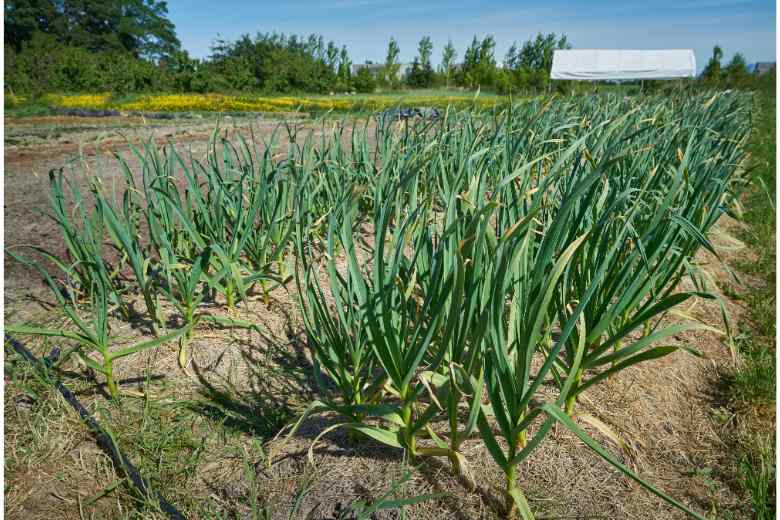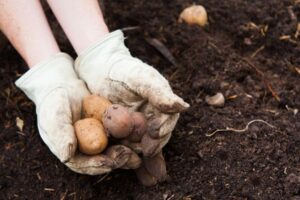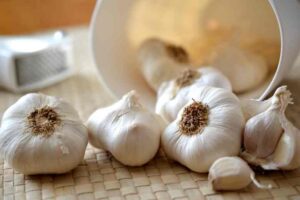
Planting garlic in Connecticut is a great way to add flavor and nutrition to your home-grown meals. There are several different varieties of garlic that can be planted in Connecticut, each with different flavors, textures, and scents.
It is important to choose the right variety for your specific climate and soil. With a little knowledge and effort, you can enjoy the delicious taste of homegrown garlic in your meals.
Preparing the Soil
Growing garlic requires well-drained, fertile soil with plenty of organic matter. Here are the steps to prepare the soil for garlic planting in Connecticut:
- Choose the right location: Garlic prefers full sun, so choose a site that gets at least 6 hours of direct sunlight each day. The soil should be well-draining to avoid waterlogging, which can lead to rot.
- Soil Testing: Test your soil to check the pH level and nutrient availability. Garlic prefers a pH between 6.0 and 7.0. You can get a soil test kit from a local garden center or your local county extension office.
- Amend the Soil: If your soil is heavy clay, you’ll need to amend it to improve drainage. You can do this by adding organic matter like well-rotted compost or aged manure. Sandy soils may also require organic matter to help them retain moisture and nutrients.If your soil’s pH is below 6.0, add some lime to raise it. If it’s above 7.0, adding sulfur can help to lower it. The soil test results should guide you on how much to add.
- Remove Weeds: Clear the planting area of weeds and other debris. Garlic does not compete well with weeds, so keeping the area clean will give your garlic the best chance of thriving.
- Prepare the Beds: Loosen the soil to a depth of at least 12 inches using a garden fork or tiller. This helps the garlic roots penetrate the soil easily. Create raised beds if your soil tends to stay wet, as raised beds can improve drainage.
- Fertilization: Add a slow-release fertilizer high in nitrogen to your soil before planting. Follow the instructions on the package for application rates. This will provide initial nutrients for your garlic to start growing.
The best time to plant garlic in Connecticut is in the fall, typically in October, so that the cloves have a chance to establish roots before the ground freezes. In the spring, the plants will continue to grow and should be ready to harvest by mid-summer.
Planting Garlic Cloves
Planting garlic is straightforward. Here’s a step-by-step guide:
- Choose the right garlic variety: There are two main types of garlic: hardneck and softneck. Hardneck varieties generally do better in colder climates like Connecticut, so you might want to choose a hardneck variety. Purchase garlic bulbs from a seed provider or nursery. Avoid using bulbs from the grocery store as these may not be suitable for your local growing conditions and could carry diseases.
- Prepare the garlic cloves: Break apart the garlic bulbs into individual cloves right before planting. Be careful not to damage the base of the cloves where the roots form. Choose the largest, healthiest looking cloves for planting, as they will produce the biggest bulbs.
- Dig holes or furrows: The holes should be 2-3 inches deep. If you’re planting multiple rows, space the rows about 12-18 inches apart. Within the row, space your cloves about 6-8 inches apart.
- Plant the cloves: Plant each clove pointy end up and the flat root end down. The top of the clove should be about 2 inches beneath the soil surface.
- Cover and mulch: Cover the cloves with soil and pat down gently. Then cover the bed with 3-6 inches of straw or other mulch to insulate the garlic over the winter, conserve moisture, and reduce weed competition.
- Watering: Water after planting if the soil is dry, but avoid creating waterlogged conditions. In general, garlic needs about an inch of water each week during the growing season.
- Spring care: When spring arrives, the garlic will start to grow. If you’ve mulched heavily, you might need to pull back some of the mulch to allow the shoots to come through. Begin regular watering as the weather warms and the soil dries out. Fertilize in early spring and again in mid-spring to support good growth.
Garlic is generally planted in the fall in Connecticut, so it can establish roots before the ground freezes. The garlic will then grow in the spring and be ready to harvest by mid-summer.
Watering and Fertilizing
Watering and fertilizing your plants is an important part of gardening. Properly watering your plants helps them to absorb the nutrients they need to grow and flourish.
Fertilizing your plants helps to replenish the depleted soil and provide the necessary nutrients for healthy growth. Together, watering and fertilizing can help create the ideal environment for lush, vibrant gardens.
With the right combination of watering and fertilizing, plants can be provided with the nutrition they need to thrive and bring joy to any outdoor space.

Harvesting Garlic in CT
Garlic is an important ingredient in many cuisines around the world, and it can also be grown in a wide variety of climates. In Connecticut, the perfect climate and soil conditions for growing garlic make it an ideal crop for home gardeners.
Harvesting garlic in Connecticut is a rewarding experience, as the garlic can be used to make delicious dishes.
The first step is to prepare the soil for planting. The soil should be enriched with compost and organic matter to ensure that the garlic has the best possible growing environment.
Once the soil is ready, garlic cloves can be planted in the fall for a spring harvest. As the garlic grows, it will need to be weeded and watered regularly. When the garlic is ready to harvest, the leaves should be cut back and the garlic can be pulled from the soil.
After harvesting, the garlic must be cured in a cool, dry place for a few weeks before it can be used. With a little work and patience, garlic grown in Connecticut can be an incredibly flavorful addition to your favorite recipes.
Benefits of Growing Garlic
Growing garlic is a great way to spice up your garden and your meals! Not only is garlic a delicious addition to any recipe, but it also has many health benefits.
Garlic is a great source of vitamins and minerals, such as vitamins B6 and C, calcium, copper, and zinc. It can help boost the immune system, reduce inflammation and cholesterol levels, and even fight off colds and the flu.
Eating garlic can also help improve digestion and reduce the risk of some cancers. Plus, garlic is easy to grow, so it’s a great way to add flavor and nutrition to your home-cooked meals.
Common Problems and Solutions
Here are some common problems that garlic growers often face and their possible solutions:
- White Rot: This is a soil-borne disease that can be a major problem for garlic. It is characterized by white, fluffy fungus on the base of the bulb and roots. The garlic plants may yellow and die back prematurely. To manage white rot, crop rotation and sanitization of tools can help. Avoid planting garlic or other plants in the onion family in the same soil for at least 5 years if white rot has been a problem.
- Basal Rot: This is a fungal disease that causes the bases of the plant and the roots to rot. Infected plants are often stunted and yellowed. The best defense is a good offense – practice crop rotation and plant only disease-free cloves.
- Nematodes: These microscopic worms can cause damage to the garlic roots. Planting cover crops like mustard or marigold can help to suppress nematodes. Crop rotation is also an effective strategy.
- Bulb and Flower Stalk Formation: Garlic can sometimes produce a flower stalk or fail to form a bulb. This is often caused by fluctuations in temperature. To encourage bulb formation, make sure to plant garlic at the right time of year, typically in the fall for Connecticut.
- Pests: Garlic has relatively few pests, but insects like thrips can sometimes be a problem. They can damage the garlic leaves, leading to reduced bulb size. Regularly check your plants for pests. If necessary, use insecticidal soaps or other environmentally friendly options for pest control.
- Nutrient Deficiencies: Yellowing leaves can be a sign of nutrient deficiencies. Regular soil testing can help you keep track of your soil’s nutrient levels, and you can supplement with a balanced fertilizer as necessary.
Remember that prevention is the best remedy for many of these problems. Crop rotation, planting disease-free cloves, regular monitoring for pests, and maintaining healthy soil can go a long way towards ensuring a successful garlic harvest.
FAQs About the Planting Garlic In Ct
What is the best time of year to plant garlic in Connecticut?
Answer: The best time to plant garlic in Connecticut is in late fall, usually October or November.
How deep should I plant garlic cloves in Connecticut?
Answer: Garlic cloves should be planted about two to four inches deep in Connecticut.
How much water does garlic need in Connecticut?
Answer: Garlic needs to be kept evenly moist in Connecticut, but not overly wet. Watering once or twice a week should be sufficient.
Conclusion
Planting garlic in Connecticut is a great way to add flavor to your dishes and to your garden. With the right preparation and care, garlic can be grown in this region. Planting garlic in the fall is the most successful way to ensure it will produce a good yield the following summer. Garlic is a relatively easy plant to grow, and can be a great addition to any garden. With its many health benefits and numerous uses in the kitchen, planting garlic in Connecticut is definitely worth the effort.






